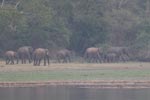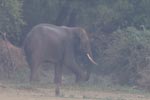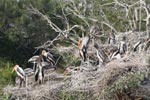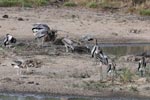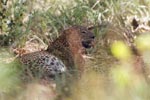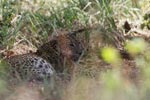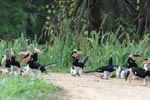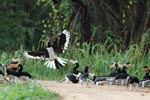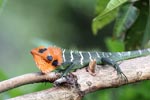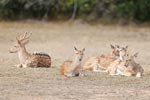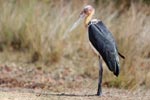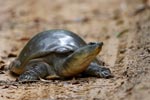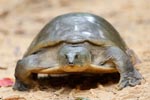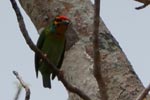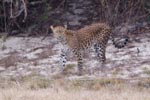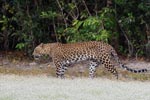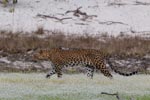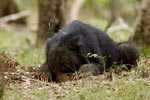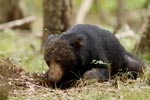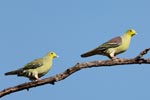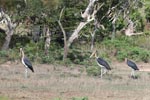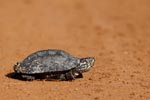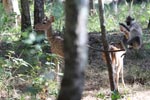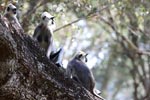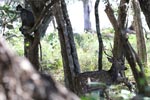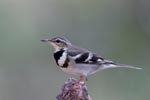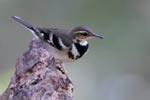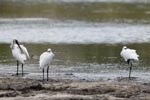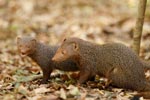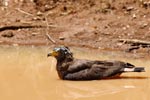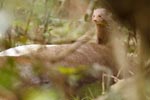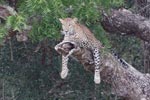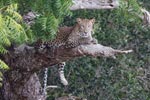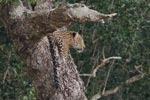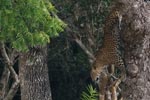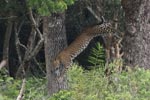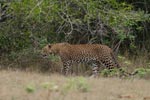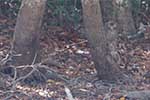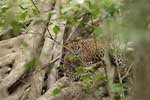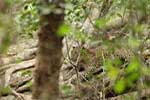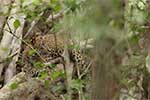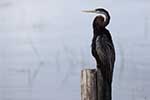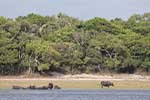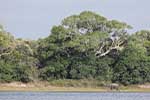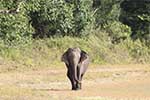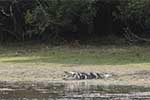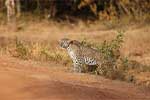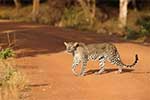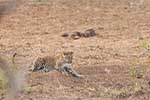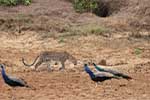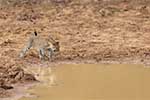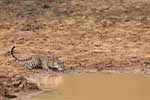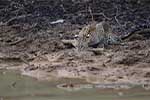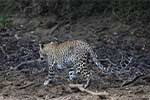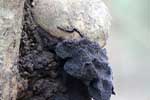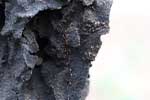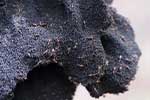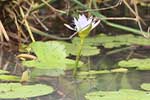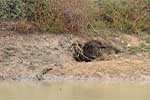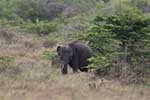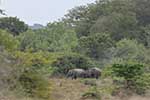
NOTES ON FIELD TRIPS TO WILPATTU NATIONAL PARK
- Wilpattu National Park 4th to 6th October 2025
6.02am a heard of 15 Elephants and two bull elephants including a Tusker at the Hunuwilagama tank. By the time I got my camera the heard was leaving to the forest. A herd of 8 Wild Buffalo and 76 Spotted Deer at the Hunuwilagama Tank.
7.18am the Painted Stork nesting at Percy Bandi Wewa had produced many juvenile birds.
8.20am an Indian Three-toes Kingfisher flew across the road and alighted on an exposed branch on Maha Wewa Road close to, Maradanmaduwa But the exquisitely beautiful bird flew off as I raised the camera.
8.46am one Leopard at Maradanmaduwa. N 08.37406, E 080.07130
The young male leopard was lying on the ground and was partly covered by the small bushes and grass. In the morning there had been three leopards at this location feeding on a young buffalo kill. Upon examination of the spot pattern, I noted that it is Maradanmaduwa Male 4 (MMMC 4), the fifth litter male cub of Maradanmaduwa Female 1 MMFC 1. According to the available data from the park this is the only female who had so far produced a fifth litter. After some time, the leopard walked in the direction of Maradanmaduwa tank and was not visible as he disappeared into the forest.
11.48am there was heavy thunder and lightning which was followed by a very heavy spell of shower.
12.07pm heavy rain and the overcast conditions created such darkness it was almost as dark as 7 pm.
6.00pm left the park.
Mammals - Elephant 17, Leopard 1, Indian Buffalo 22, Sambhur 6, Spotted Deer 290, Ruddy Mongoose 2, Toque Monkey, Grey Langer, Indian Grey Mongoose, Giant Squirrel, Indian Palm Squirrel.
Reptiles – Mugger Crocodile 5, Flapshell Turtle 1, Black Turtle 7, Land Monitor, Common Garden Lizard, Green Garden Lizard, Low-land Kangaroo Lizard, Devaka’s Fan-throat Lizard.5th October 2025
6.56am Susil Kumara, the owner of Dolosmahe guest house, called to tell me that many Malabar Pied Hornbills had gathered on the bund to feed on the winged termites. As I walked on to the bund many of them flew up on to nearby trees. I retreated, waited until they moved back and crawled up to them one foot at a time. It was quite interesting to observe how they picked the insects with their large beaks and flick them into their wide-open mouths.
Also captured a displaying Green Garden Lizard in the garden. This is the largest species of agamid lizard in the country in terms of body length.
7.13am entered the park.
8.06am 5 Spotted Deer lying on the ground between Thammanna Wala and Divulgas mandiya. They were “chewing the cud” with members facing opposite directions at the center of an open glade. The weather was quite mild due to the overnight rain and the overcast conditions. It was apparent that this small herd decided to rest at this open space to protect themselves from Leopards. I have observed this strategy of individuals facing all directions on many occasions when Spotted Deer are feeding or resting. In the case of a small herd, such as this their instinctive behaviour was quite evident. The primary hunting strategy adopted by a leopard is to conceal itself among foliage and move as close as possible to its prey prior to launching an ambush attack. Thus, deer opt to spend the night in an open space with members facing all directions to increase their chances of detecting the predator that may approach them.
9.00am an Adjutant Stork at Borupan Pitiya.
11.25am a Sri Lankan Flapshell Turtle between Kattarambu Villu and Mana Wila. I was not able to move forward as the turtle was walking towards me on the road. I reversed the vehicle and moved on to a by road permitting the slow-moving creature to go on its way without any hindrance. Every 10 to 15 feet the animal would rest before commencing its walk again and was not disturbed by the troop of Grey Langur’s that were quite active in the trees above the road.
These turtles are found in the lowlands throughout the country but are rare in the higher hills. This is an endemic species.Even though the conservation status of the species is regarded as “Least Concerned” (National Red List 2012), the Flapshell Turtle is strictly protected under schedule II of the Fauna and Flora Protection Ordinance as amended by Act No. 22 of 2009, due to the steady decline of its numbers.
The Flapshell Turtle used to be extremely common in most water bodies throughout the lowlands about three decades ago but have become less plentiful in localities outside protected areas due to poaching. In the early seventies they were a common sight at the lake in Kandy along with the more common Parker’s Black Turtles. They are rarely seen at this locality now. They are, however, common in tanks, ponds and other stagnant water bodies of all the dry zone national parks and sanctuaries. Even though less plentiful, they are also found at locations such as large marshlands, forest pools etc., where there is adequate cover for them to subsist without being detected. In the North I have seen them in the island of Mannar and the Jaffna Peninsula. They are still found in the water bodies close to Colombo such as the Attidiya, Talangama and Kotte Marshes. Though not found in the higher hills, I have seen them on a few occasions at altitudes up to 1,300 meters in the Uva Hills and the foothills of the Knuckles Forest Reserve. They are usually seen in rivers, streams, ponds, lakes, paddy fields and tanks but prefer quiet, shallow, stagnant water bodies with plenty of cover.Other than preying on small aquatic creatures, these turtles play an important role in keeping waterways clean by scavenging on most rotting material, bodies of dead animals, snails etc. They use their considerably long necks very effectively to hunt fish. The turtle would slowly approach its prey with its neck contracted and when the prey is within reach, would propel its head forward by extending the long neck at great speed. In one swift motion its jaws will snap shut, trapping the unsuspecting fish.
During periods of drought these turtles are known to move from one waterhole to another and would also burrow in the soft mud and enter a state of “hibernation”: they have been reported to survive more than 5 months at a stretch until the rains arrive when they emerge from their slumber.
In Wilpattu this species is common in most water bodies. During the dry season they are often seen leaving the pools they occupied in search of other water bodies.
12.18pm a Ceylon Small Barbet making its continuous monotonous call from the top branch of the Thelambu Tree beyond Herath Hamy Wala (formerly known as Thelambu gas Wala). This is a very common species in the wet zone but is only found in small, scattered colonies in the dry zone.
3.44pm one leopard at Kuruttupandi Villu. N 08.43845, E 079.98248
I was parked at this location from 1.30pm and was quite please to observe an adult female leopard emerge from the forest. She remained seated at the edge of the forest for a few minutes and walked passing the “Kok Mota” fields before moving into the forest in the direction of Manik Wila. Later upon examining the spot pattern I noted that it is Manikrala Uraniya Female 1 (MRUF 1), popularly referred to as the Kuruttupandi female by the safari jeep drivers. Her second litter consists of a male and a female cub ( Kuruttupandi male 1 and Kuruttupandi female 1), who are regularly seen at this location and are now one year and seven months of age. These cubs would leave her company to lead independent lives within 4 to 5 months from now.5.15pm a Sloth Bear at Maradanmaduwa. The bear had dug up a termite hill and was feeding on the insects. The heavy rains received by the park yesterday had softened the hard exterior of these usually very had termite hills. It is a usual practice for many termite hills to get raided by bears during the first rains after the dry season.
6.00pm left the park
6.12pm a heard of 15 Elephants and 102 Spotted Deer at the Hunuwilagama Tank.
Mammals – Elephant 15, Leopard 1, Sloth Bear 1, Indian Buffalo 10, Sambhur 1, Spotted Deer 277, Wild Boar 5, Ruddy Mongoose 2, Black-naped Hare 2, Toque Monkey, Grey Langer, Small Indian Civet, Giant Squirrel, Indian Palm Squirrel.
Reptiles – Mugger Crocodile 4, Flapshell Turtle 1, Black Turtle 5, Land Monitor, Common Garden Lizard, Green Garden Lizard, Low-land Kangaroo Lizard, Devaka’s Fan-throat Lizard.
6th October 2025
7.09am entered the park.
7.48pm photographed a pair of Ceylon Green Pigeons at Palu Kola Wala.
This is a species endemic to the country. It is found in forests and well-wooded areas of the lowlands and mid hills. The mantle of the male is maroon in colour.These pigeons have a remarkable ability to conceal themselves among the foliage by “freezing” when they detect any danger such as being approached by humans. They feed on small fruits of species such as Banyan, Bo, Madan and Palu. When these trees are in fruit in a forest these pigeons will invariably visit these trees in large numbers. In the dry zone they are often accompanied by Orange-breasted Green Pigeons. This pretty pigeon has a beautifully modulated human like mellow whistle, which is often heard, in the forested areas. Even though the call is heard locating them in a tree, even with a pair of binoculars, can be quite hard. If one is patient and is willing to wait for some time, observing the tree where the calls emanated the quarrelsome nature of this species will often result in a few having to move from their concealed positions among the foliage making it easy to detect them.
This species is quite common in Wilpattu and they visit the Jam fruit trees in my garden every day to feed on the ripe berries. They are often found among the foliage and is difficult to photograph on exposed branches. The best way to photograph them at Wilpattu is to wait at a water hole during the dry season (end July to mid-September) where they visit during midday for a quick drink.
8.00am 4 Adjutant Storks at Maradanmaduwa.
This is the second largest species of stork in the country and is generally found in water bodies close to or surrounded by forest. This is essentially a bird of the dry lowlands and has never been reported from the wet zone or the hills. Even though the Lesser Adjutant is known to breed in the country and young birds have been observed on many occasions, no one has been able to study its nesting behaviour, as a nest is yet to be found in Sri Lanka. Outside Wilpattu the highest number of this species that I have encountered at one site has been 6 birds in Wasgomuwa National Park (December 1998), 13 at Lahugala National Park (September 2002) and 6 at Minneriya National Park (July 2003).
In Wilpattu, however on the 2nd of September 2012, during the height of the drought, I counted 17 birds at the Maradanmaduwa tank and on the 30th of the same month I observed a rare congregation of 23 birds at the same locality which happens to be one of the highest counts of this rare species that had been reported in the country. Throughout the year one or two of this species can be observed at most water bodies at Wilpattu. Manikkapola Uttu is a location that is generally preferred by this species and a few birds are usually seen feeding among the reeds during the greater part of the day. Undoubtedly Wilpattu is a key stronghold for the survival of this species.8.03am a tiny Black Turtle on the road. I alerted the safari jeep driver devinda, who was behind me to be cautious since the tiny reptile was difficult to detect looked almost like a speck of dirt. Thankfully the little creature ran across the road to safety.
10.00am a troop of Grey Langurs in the company of Spotted Deer at Maradanmaduwa. The symbiotic relationship that exists between these two unrelated species is quite fascinating. The deer fed on the grass and the leaves dropped by the monkeys and most of the young langurs were on the ground chasing each other playfully while others fed on plants and fallen fruits etc. The relaxed atmosphere was suddenly broken by the alarm call of an Indian Peafowl. The monkeys immediately took to the trees and started to look in the direction of the alarm call from the top and the deer looked from below. The increased protection available to both these species in this relationship in detecting the presence of a predator was quite apparent.
8.27am a Forest Wagtail that was by the side of the road at Thambioluwa flew on to an exposed log permitting me to get a few images.
This is a common migrant, which is found throughout the island during the season. It breeds in eastern Asia, Korea, and China and in Siberia. In winter it migrates to southern India and Sri Lanka. This is the only wagtail that moves its hindquarters sideways.
This species is a common migrant to Wilpattu. As it is well camouflaged on the roads it is difficult to spot until you are very close. Often it would fly off the road upon being approached by a vehicle while making its “chink chink” call and settle on a branch few feet above the ground. It can be seen on shady forested roads throughout the park.
9.55am a Brown Fish Owl between Kokkare Villu and Kuruttupandi Villu.
11.01am five Spoonbills at Borupan Wila.
11.07am two Ruddy Mongoose between Borupan junction and Walas Wala.11.16am a Crested Serpent Eagle in belly deep water in the pool at Humbas Wala. Many species of raptors engage in “bathing” to cool off during the mid-day heat.
11.40pm I was informed of a Sambhur kill between Thammanna Wala and Percybendi Wewa and decided to wait for the leopard despite the kill being quite close to the mani road. The kill was about 20 feet from the main road and was partly visible through the bushes. It was intact except for the stomach indicating that it had been killed during early hours of the morning and had not been consumed after park was opened perhaps due to the frequent movement of vehicles. When a large animal is killed leopards will first feed on the softer organs by opening the stomach. A Ruddy Mongoose arrived at the kill and started to feed. He was quite vigilant and would survey the area regularly for any signs of the leopard. While the mongoose was at the kill, I heard a short growl which made the small carnivore run into the forest. But the leopard did not arrive at the kill. It was apparent that the cat was lying close by. There is a very shy female with two cubs that frequent this area. It is likely that she had made the kill and would wait for vehicle movement to cease prior to approaching the kill. Around 2pm upon being informed of a leopard sighting at Maradanmaduwa I decided to leave.
2.43pm one Leopard at Maradanmaduwa “Kukul Katu Pitiya”. N 08.37228, E 080.07201
The young male leopard was lying on an exposed branch of an old Margosa Tree growing by the edge of the open glade. Upon examining the spot pattern, I noted that it is Maradanmaduwa Male 4 (MMMC 4), that I observed the day before close to this location. Around 4.56pm the leopard descended from the tree and walked into the forest in the direction of the Iririgollawa road.5.11am a Sloth Bear at Maradanmaduwa.
6.00pm left the park
Mammals - Leopard 1, Sloth Bear 1, Indian Buffalo 23, Spotted Deer 129, Wild Boar 6, Ruddy Mongoose 2, Black-naped Hare 2, Toque Monkey, Grey Langer, Indian Grey Mongoose 2, Giant Squirrel, Indian Palm Squirrel.
Reptiles – Mugger Crocodile 7, Flapshell Turtle 1, Black Turtle 7, Star Tortoise 1, Land Monitor, Common Garden Lizard, Low-land Kangaroo Lizard, Devaka’s Fan-throat Lizard.Birds, Butterflies & Flora observed during the field trip
Birds – Lesser Adjutant, Painted Storks, White-necked Stork, White Ibis, Indian Three-toed Kingfisher, Brown Fish Owl, Lesser sand Plover, Common Red Shank, Forest WagtailButterflies - Blue Mormon, Red Spot Duke, Common Mormon,
Wild Orchids – Taprobanea spathulate, Vanda tessellate
Fruiting trees – Madang, Ilapaththa
- Wilpattu National Park 5th to 6th September 2025
On the 7th of May 2025 the Supreme Court made a landmark order terminating the proposed public road construction project through Wilpattu National Park from Eluwankulama to Marichchakaddi and handed over the management of the road back to the Department of Wildlife Conservation. The EFL and the WNPS filed this fundamental rights application in 2010, challenging the proposed project. It was a day of victory not only for the applicants but for all the protected areas and wildlife of this country. This order brought an absolute sense of relief and joy to me and many others who were devastated by the proposed public road through one of the most sensitive areas of our largest and oldest national park. I look forward to study the fauna and flora of this area by making visits as frequently as possible. This North-western area of the park is the preferred habitat for the Elephant population in the park.
Since Friday the 5th of September 2025 was a holiday, I had planned to study and record the wildlife of the north-western part of the park for two days by entering from the Euwankulama entrance. I arrived at my lodging at Wanathavilluwa on the 4th night to enter the park early morning the next day.
Amith arrived at 5.30 in the morning and having packed the camera gear we left to reach the park entrance.
6.05am enterd the park with Safari jeep driver Amith Wirasinghe.
6.06am a bull elephant on the road between the park entrance and the first broken culvert. As the young bull walked towards us but reluctantly moved off the road about 30 feet ahead of where the vehicle was parked. 3 Spotted Deer crossed the road behind the elephant, and a Sri Lankan Jackal moved on to the road following the deer. The Jackal, our third largest mammalian carnivore in the island is the only “wild dog” species in the country. Upon seeing the vehicle, he started to trot in the direction of Pomparippu and moved into the forest.
6.08am Grey Langurs and Toque Monkeys were making frantic alarm calls indicating that they have spotted a leopard from their vantage points on the treetops. We parked by the road expecting the leopard to move on to the road for about 15 minutes but the alarm calls moved away from the road suggesting that the leopard moved further into the forest.
6.30am a herd of 8 Spotted Deer at Pomparippu Pitiya.
6.35am the road leading up to and beyond the water hole at Wellanmundalama junction had fresh pug marks of two leopards and a Sloth Bear paw prints other than those of other mammals.
7.10am a Ruddy Mongoose between Wellamudalama junction and Periya Villu.
7.30am a Barking Deer between Wellamundalama and Periya Uppu Villu.
8.15am we drove down to Periya Uppu Villu and observed a small herd of 5 Spotted Deer. While looking around for any animals we observed the deer were agitated and started looking into the forest. After a few minutes they started to run in our direction. However, despite them not making any alarm calls we decided to move on to the road to check out the area they were looking intently. We observed fresh pug marks on the road and stopped to see in what direction the cat had moved. Just then a leopard sprinted across the road and disappeared into the forest. The agitation of the deer was quite clear. Perhaps they did not make any alarm calls as they only detected the scent of the leopard.
10.07am a bull elephant in musth at Periya Uppu Villu. He was at a distance but decided to walk straight at us up to about 15 feet from the vehicle but having moved close he walked away with no hostility.I wanted to move along the main road towards Mollikulama prior to any other vehicle to observe the animal foot prints on the sandy road. We drove almost up to Pukkulama junction. I was quite pleased to observe many fresh prints of Elephant, Leopard and Sloth Bear at many locations along the road indicating a good diversity of animals occupying this area of the park.
10.20am two Ruddy Mongoose between Periya Villu and Maila Villu.
I was keen to visit the Villus by the side of the road up to Pukkulama junction. The first water body beyond Malila Villu is Aalam Villu the next is Thamakka Villu and the third is Thanga Villu. All these had fair amount of water with many species of water fowl such as Lesser Whistling Teal and Painted Storks.
10.58am Arrived at the body of water located at the Palugahathure junction which gets separated from Periya Naga Villu during the dry season. This pool is referred to as the “crocodile pond” by the safari jeep drivers as a large number of Mugger Crocodiles can be observed at this location during the dry season. On previous occasions I had observed an interesting behavior of small fish that continue to leap out of the water in this pond even when not pursued by crocodiles. I was quite keen to photograph these fish to identify the species and find out the reason for such behavior as well as to capture the crocodiles in the act of catching fish.
I have never observed any newly born crocodiles here. My safari jeep driver Amith also confirmed that neither he nor the other safari jeep drivers have observed immature animals except for the adults. Thus, it is clear that they do not breed here but congregate mainly to feed on the fish that gets trapped by the water level going down. These large reptiles dive down where only their tails are visible above the water and move up sideways with a splash trapping the fish in their jaws. As they do this some fish leap out of the water to escape. I wanted to capture this activity and also to photograph the fish as they jump out of the water. I told Amith to park the vehicle enabling us to see the pool. The crocodiles moved underwater as we approached but appeared after a while to engage in “fishing”. There were about 7 adult muggers and the larger reptiles chased the smaller ones that move towards the areas occupied by them. Each time when a crocodile moved under water the fish would jump out indicating the movement of the reptile. The challenge was to capture the crocodile and the leaping fish in the same frame. After more than one and a half hours of effort I was fortunate enough to capture a few images with the fish leaping out of the water to escape the crocodile. Except for one occasion where I captured a Thilapia leaping out to escape a crocodile, in all other images the species of fish was Climbing Perch or “Walking Fish” Anabas testudineus referred to as “Kavaiya” in Sinhala. This is a species of amphibious fish that can live for almost 6-10 hours even out of water. During rainy season they move long distances by crawling with the use of their pectoral fins and gill covers which has sharp edges in search of new water bodies to colonies. They are very hardy fish and can even withstand much greater levels of polluted water than most other species. Unlike on earlier occasions I did not observe the fish jumping out of the water at this pool other than to escape the crocs. This year due to a few unexpected heavy spells of rain received during the previous months the pool is till connected to Periya Naga Villu and is filled to the brim. The areas where the crocodiles used to bask in the sun are still under water.
1.06pm about half a kilometer from the “crocodile pool” towards Periya Villu is another pool of water. I wanted Amith to park the vehicle to observe the behavior of fish here. The fish was jumping out of the water continuously despite there being no signs crocodiles. We spent about half an hour here and there were no crocodiles to be seen. The noise of the fish leaping into the air and falling back was quite loud as if someone was continuously pelting stones into the water. I managed to get a few images of the leaping fish, and they were all Climbing Perch. Unlike most other species of fish, the Climbing Perch possess an air breathing organ other than their gills that enables them to breath and live out of water for up to about 7 to 10 hours. It is very likely that the reason for these fish to keep leaping out of the water is due to the depletion of oxygen level in the water. The term used to explain the level of oxygen in water is “Dissolved Oxygen” (DO). What causes such depletion of oxygen in a pool which is in the middle of the jungle was the next matter I had to resolve. Reading up on the subject revealed that the main reasons for low Dissolved Oxygen levels in water is the increase in temperature, decaying organic matter from aquatic plants and algae, and changes in whether. The very high temperature in these areas and the other factors mentioned directly apply to the conditions prevalent in this pool. This pool was not connected to any other water body on the surface thus the conditions for low dissolved oxygen should have been present here with greater intensity. Therefore, it is quite clear that Climbing Perch with their ability to breath air directly can survive in such poor-quality water unlike most other species of fish. However, these fish possess a specialized labyrinth organ and a folded structure located above their gills which allows them to absorb oxygen from air. Usually they periodically swim to the surface of the water to gulp air in to the suprabranchial cavity containing the labyrinth organ for this purpose. Thus, there had to be another reason for these fish to continuously engage in such energy consuming behavior of leaping into the air. As I was not able to find any explanation in the literature, I consulted Dr. Samantha Suranjan who offered a possible explanation even though he insisted that it is only an educated guess which needs to be proven.
As we are aware some villus in wilpattu are connected with the sea through the cavities in the limestone layer beneath the earth. These water bodies contain sea water as the bottom layer of water. During the rainy season they receive large amounts of fresh water that form the upper layer of the villu since fresh water will float on sea water. Animals will drink form this upper layer and aquatic life forms will occupy this upper layer of water of the villu. When the temperature levels rise during the dry season this layer will gradually evaporate and the lower layer will turn into brine (a strong solution of salt water). The rise in temperature and the decomposition of aquatic plants /algae will add to the depletion of oxygen. Many species of aquatic life that cannot withstand the lower levels of oxygen and higher levels of salinity will continue to perish. Most will become easy prey to predators. The resilient Climbing Perch will remain in these pools as much as they can but will continue to leap out to escape the irritation caused by the higher concentration of salt as the fresh water continues to evaporate. A study of water samples from these pools at different depths is needed to confirm this sad but interesting hypothesis.
1.30pm a Mugger Crocodile and a Flapshell Turtle at the pool across Periya Uppu Villu.
2.15pm pm since we had a sighting of a leopard at Periya Uppu Villu in the morning I decided to park at this location. There were two Elephants, a mother and calf feeding across the water.
3.06pm the two Elephants moved to the edge of Periya Uppu Villu and walked across the water. While moving across the calf submerged under water on a few occasions perhaps to seek relief from the intense heat.
4.01pm a Mugger Crocodile climbed on to an exposed earth bank at Periya Uppu Villu.
4.35pm since there was no signs of any leopard we decided to leave. As we were leaving observed another 2 elephants walking in to Periya Uppu Villu.
4.50pm a Ruddy Mongoose at Pomparippu.
5.00pm 9 Spotted Deer at the Pomparippu beat office premises.
5.14pm 7 Mugger Crocodiles at Uththamadaru Bridge.
5.30pm 2 elephants, a mother and a small calf at Moolakandaweli plains.
6.00pm left the park.
Mammals - Elephant 6, Leopard 1, Spotted Deer 25, Barking Deer 1, Sri Lankan Jackal 1, Ruddy Mongoose 3, Black-naped Hare 1, Toque Monkey, Grey Langer, Purple-faced Leaf Monkey, Giant Squirrel, Indian Palm Squirrel.
Reptiles – Mugger Crocodile 20, Flapshell Turtle 1, Land Monitor, Common Garden Lizard, Green Garden Lizard, Devaka’s Fan-throat Lizard.
6th September 2025
6.04am entered the park.
6.05am a Sri Lankan Jackal between the park entrance and Moolakandaweli plains.
6.28am 2 Black-naped Hare and three Spotted Deer at Pomparippu pitiya.
6.35am one Leopard between Pomparippu and Wellamundalama.
As we passed an area cleared for the removal of gravel, I noticed some animal moved across an open area to our left. I stopped and looked to see it was a leopard that moved hurriedly in to the forest. The shy cat moved in one motion and disappeared into the forest.
7.21am a Ruddy Mongoose at Periya Uppu Villu.
8.13am the wild orchid commonly referred to as the Anuradapura orchid Vanda tessellate photographed between Maila Villu and Palugahathurei junction.
8.20am a Ruddy Mongoose between Palugahathurei and Periya Villu.
8.22am a Black-naped Hare between Periya Villu and Kollan Kanatta.
8.38am a Ruddy Mongoose at Periya Uppu Villu.
9.02am a Barking Deer crossed the road between Periya Uppu Villu and Wellamundalama.
9.16am 7 Spotted Deer at Pomparippu.
9.23am a Ruddy Mongoose at Pallekandal Pitiya.
9.33am I decided to wait at Pilli Motte to record the animals that come to water. I have a special affinity towards this pond as I provided the funds to build this pond, and it was located and built with my instructions. A barking Deer was drinking when I arrived.
9.35am Barking Deer moved to drink water at Phill Motte.
10.55am Barking Deer moved to drink water at Phill Motte.
11.05am Barking Deer moved to drink water at Phill Motte.
11.15am Barking Deer moved to drink water at Phill Motte.
12.45pm Barking Deer moved to drink water at Phill Motte.
1.56pm a Brown Fish Owl flew down to the foot of a tree at Phill Motte.
2.05am as there was no signs of leopard, I decided to leave my vigil at Phill Motte.
2.06pm a troop of Grey Langur between Phill Motte and Pallekandal Pitiya.
2.46pm 2 Elephants at Periya Uppu Villu.
3.20pm 2 Spotted Deer at Maila Villu.
3.44pm 6 Spotted Deer and a Lesser Adjutant Stork at Sinna Uppu Villu.
3.55pm 3 Spotted Deer at Periya Uppu Villu.
3.58pm 2 Ruddy Mongoose at Periya Uppu Villu.
4.09pm another Ruddy Mongoose between Periya Uppu Villu and Pomparippu.
4.31pm a small herd of 5 Elephants at Pomparippu Pitiya.
4.35pm a herd of 6 Spotted Deer and 7 Mugger Crocodiles at Uththamadaru Bridge.
4.39pm a Black-winged Kite close to the Uththamadaru Bridge.
4.52pm a troop of northern, Purple-faced leaf Monkey feeding on Leaves of a Kumbuk Tree Terminalia arjuna at Uththamadaru Bridge.
5.03pm Grey Langurs and Toque Monkey drinking at the “broken culvert pool” between Uththamadaru bridge and the park entrance.
5.20pm left the park.
Mammals - Elephant 2, Leopard 1, Spotted Deer 27, Barking Deer 7, Sri Lankan Jackal 1, Ruddy Mongoose 7, Black-naped Hare 3, Toque Monkey, Grey Langer, Purple-faced Leaf Monkey, Giant Squirrel, Indian Palm Squirrel.
Reptiles – Mugger Crocodile 7, Land Monitor, Common Garden Lizard, Green Garden Lizard, Devaka’s Fan-throat Lizard.
Birds, Butterflies & Flora observed during the field trip.
Birds – Lesser Adjutant, Painted Storks, White-necked Stork, Spoonbill, Black-winged Kite, White-bellied Sea Eagle, Common Red Shank, Wood Sandpiper, Common Sandpiper
Butterflies - Banded Peacock, Monkey Puzzle, Blue Mormon, Common Mormon
Wild Orchids – Vanda tessellate
Fruiting Trees - Kiri Kone, Ilapaththa
Wildflowers – Wellangiriya
- Wilpattu National Park 30th to 31st August 2025
Arrived at the jungle house on the 30th Saturday around 3.30pm to attend a function in the village on Sunday morning.
A pair of Brown-headed Barbets had nested in one of the three coconut logs that had been erected in the garden to attract Woodpeckers.
As it was the dry season in Wilpattu many species of mammals arrive at the Hunuwilagama tank throughout the day in search of water. Thus, I decided to remain at the bungalow without going to the park to photograph animals that would come to this tank. There were many large Mugger Crocodiles basking in the sun at the water’s edge. I counted nine of them.
There were scattered herds of Spotted Deer totaling up to 72 animals feeding on the fresh grass growing on the areas exposed by the receding water.
Around 5.30pm I was quite pleased to observe a herd of Elephants emerge from the jungle. The family group of 12 animals consisted of a sub adult tusker and two calves. Despite having arrived at the tank all members of the herd patiently remained without approaching the water until the matriarch decided that it was safe to do so. Once they reached the water it was wonderful to watch the calves rolling in the water and splashing water with their tiny trunks. Even the adults engaged in playful interactions with others. Despite their obvious desire for a drink, it was fascinating to see how the whole herd spent almost 10 minutes prior to approaching the water until the matriarch decided that it was safe.
By 6.00pm another small herd of 5 Elephants emerged from the forest. This second herd was followed by three middled aged bull elephants. One was a tusker. The tusks of this animal were symmetrical, and he had all the signs of growing up to be a majestic animal with an impressive pair of tusks.
Intermittent trumpeting and guttural sounds of the elephants were heard well into the night.
31th August 2025
Other than the left-over rice from the kitchen which is left by the pond at dusk for the turtles I have instructed the caretaker to leave a few sour bananas every morning at the bird feeder in the garden. I always take some extra fruits each time I visit. Usually most is consumed by the resident pair/family of Malabar Pied Hornbills. Many species of birds are attracted to these bananas. including the Small Indian Civets Cats and Common Palm Civets that feed on the left-over rice. I purchased a bunch of over ripe sour bananas on my way to Wilpattu and placed it in the bird feeder. I wanted to do this for some time to see what other species of birds would be attracted. The resident pair of Malabar Pied Hornbills gorged on the bananas the previous day as well as in the morning and left with plenty of fruits still left on the combs. The previous night the aroma of the ripe bananas attracted the Common Palm Civets, Small Indian Civets and many species of Bats. Once the Hornbills left a Jerdons’s Leafbird flew in and fed on the left-over bananas.
A pair of Barking Deer and a herd of 3 Elephants arrived at the tank around 7.00am to drink water. A White-bellied Sea Eagle was circling above the tank while making its loud “honking” calls
While photographing the elephants a male Golden-backed Woodpecker alighted on one of the coconut logs erected close to the bungalow. The bird inspected the log for some time and left. It is likely that they would nest in one of these logs soon.
- Wilpattu National Park 11th to 17th August 2025
Arrived at the Jungle house at Wipattu around 10.30am. I counted 7 large Mugger Crocodiles at the water’s edge at Hunuwilagama Tank. The bungalow keeper informed me that a baby Crocodile had arrived at the garden pond the day before. The previous resident crocodile that used to feed on the left-over rice put out for the turtles had left some months ago. The tiny reptile was basking in the sun at the edge of the pond for some time and climed on to the log in the center of the pond.
12.08pm entered the park.
12.29pm a Buffalo and an adult male Wild Boar at Percy Bendi Wewa.
The Painted Stork nesting colony at this water body appear to have expanded with many nests being built even on the adjoining Palu Tree. The nests had immature birds at differeewnt stages of growth.
12.52pm a Barking Deer between Palu Kola Wala and the ‘Sohon Pitiya” pond.
1.15pm a troop of Purple-faced Leaf Monkey between Boralu Wala and Ibba Wala. They were having a mid-day rest which permitted me to get a few images. At Wilpattu it is difficult to capture good images of these monkeys as they are quite shy and occupy the tree canopy. This species is endemic to Sri Lanka. Four subspecies have been recognized. Northern Purple-faced Leaf Monkey S.v.philbricki, the race found in Wilpattu, occurs in North & East Sri Lanka (dry zone) at elevations up to 1500 meters, the East Matale Hills and Madulkele Hills. This is the largest of the races and can be seen in Trincomalee, Ritigala, Polonnaruwa, Minneriya, Habarana, Sigiriya, Mullaithivu, Kantale, Eluwankulama and Wilpattu. Their diet mainly consisit of leaves, fruits and tender shoots. Other than to drink water they are seldome found on the forest floor.
Wilpattu is one location where this species lives along with its cousin the Tufted Grey Langur Semnopithecus priam. I have seen them at Eluwankulama, Pomparippu, Maradanmaduwa, Palu Kola Wala and at Ibba Wala.
4.16pm a Black-naped Hare ran on to the road at Kuruttupandi Villu.
4.17pm A young male leopard at Kuruttupandi Villu. N 08.43651, E 079.98228
Having photographed the female I drove back to check on the leopard that was sleeping on the Ficus tree. The jeep drivers informed me that it had descended from the tree and had walked into the thicket. I decided to drive down to the villu, expecting the leopard to break cover. After a few minutes a fine young male leopard moved out of the forest to lay down on a white sand patch. I had received images of this cub with its mother and its sibling that I just photographed. It was the male cub of the second litter of Manikrala Uraniya Female 1 (MRUF 1). Despite being of the same age (one year and 4 months) difference in size of the male was obvious. I was thrilled to have capture both these cubs that had eluded me from mid last year. As this is my first sighting of this cub, I named it Kuruttupandi Male 1 with the code KRPMC 1 for the purpose of my study.
1.30pm 2 Buffalo at Borupan Wila.
2.34pm a Mugger Crocodile at Mahapatessa.
3.05pm one Leopard at Kumbuk Wila Pitiya. N 08.42182, E 080.00771The adult female was lying down under the shade of a Madang Tree. It was Kumbuk Wila Female 2 (KWFC 2) popularly referred to as Cleopatra. She is 10 years and 6 months of age now and had already produced two successful litters of two cubs each. Her last litter was in July 2023 and the two cubs, a male and a female, had left her. She should be having a third litter by now. I identified the leopard while photographing with the familiar spot pattern of her forehead.
3.18pm 2 Buffalo at Kudapatessa.
5.15pm a Sloth Bear between “Eda Kohomba Gaha Pitiya” and Andaragollawa junction.
5.37pm one Leopard at Percy Bendi Wewa. N 08.33393, E 080.12952 The leopard was stalking a herd of Spotted Deer and was almost concealed in the tall grass. Only its head was visible. I managed to get a few images and drove off to reach the park entrance by 6.00pm. Later upon examination of the spot pattern and the images taken by others prior to my arrival I noted that this is Maradanmaduwa Female 3 (MMF 3). This female was born in March 2017 in Maradanmaduwa and is now in her prime at 8 years and 5 monmths of age. She is one of the two cubs of the second litter of Maradanmaduwa Female 1 (MMFC 1). 6.00pm left the park.
Mammals - Leopard 1, Sloth Bear 1, Indian Buffalo 5, Spotted Deer 13, Wild Boar 1, Barking Deer 1, Ruddy Mongoose 2, Toque Monkey, Grey Langer, Purple-faced Leaf Monkey, Giant Squirrel, Indian Palm Squirrel.
Reptiles – Mugger Crocodile 9, Black Turtle, Land Monitor, Common Garden Lizard, Green Garden Lizard, Low-land Kangaroo Lizard, Devaka’s Fan-throat Lizard.
12th August 2025
6.10am 2 Wild boar and 4 large Mugger Crocodiles at Hunuwilagama Tank.
7.20am entered the park.
7.24am a Barking Deer at Ranawara Pitiya.
7.48am a Ruddy Mongoose at Divul Pitiya.
7.52am a male Barking Deer between Divul Pitiya.
8.02am another Barking Deer at Palu Kola Wala.
During the dry season these small herbivours can be often seen visiting water holes.
8.12am a sub adult Crested Hawk Eagle in its first year of life at Maradanmaduwa.
8.32am a Mugger Crocodile at Walas Wala.
8.52am a Drongo Cuckoo at Kokkare Villu.
This interesting bird which resembles a Drongo in appearance is inafct a cuckoo. They are known to lay their eggs in the nests of Black-fronted Babblers and the immature birds, are covered with white spots, which disappear as the birds reach maturity. In adult birds white spots/bars will remain in the under tail and undertail-coverts. This species is found throughout the Park in Wilpattu. Its ascending six-note call is often heard during the breeding season from about late December until March. This is a bird that is often heard but seldome seen as it usually ocupies the canopy.
9.45am two Leopards at Kuruttupandi Villu. N 08.43847, E 079.98241
The young male leopard was lying down under the shade of a small tree across the villu. It was difficult to spot the leopard with the naked without the aid of binoculars. He would occasionally raise his head to investigate any thing that distracts him or shift position to move from direct sunlight falling on him but go back to sleep. Upon examination of the spot pattern, I noted that this is Kuruttupandi Male 1 (KRPMC 1), one of the second litter cubs of Manikrala Uraniya Female 1. He is around one year and six months of age now and is often seen together with its female sibling. Leopard cubs stay in the company of their mother for about two years. Despite having got a few images I was keen to remain at this location due to the possibility of seeing its sibling and the arrival of their mother. Thus, I parked at the edge of the area enabling other safari vehicles to move out once they have seen the leopard.
11.25am another leopard was seen seated to the edge of the forest, remained seated for a few minutes and moved down to the edge of the water and started drinking. After drinking for about 5 minutes, she moved in the direction of the sleeping leopard but lied down briefly prior to moving into the forest. I checked her spot pattern and realized that this is Kuruttupandi Female 1 (KRPFC 1), the female sibling of the sleeping leopard.
12.50pm sunlight started to fall on the sleeping KRPMC 1. He stood up, yawned and moved from where he was sleeping. I expected him to walk down to drink but he moved under another bush and lay down again.
I stayed at this location until 3.30pm expecting further leopard activity but since there was none decided to leave.
5.01 one Buffalo at Humbas Wala.
5.25pm one Buffalo between Divul Pitiya and Andaragollawa junction.
5.55pm left the park.
6.12pm one Elephant drinking at Hunuwilagama tank.
7.30pm a Small Indian Civet at the feeding station by the garden pond feeding on the left over rice put out for the Turtles.
Mammals - Elephant 1, Leopard 2, Indian Buffalo 2, Sambhur, Spotted Deer 131, Wild Boar 2, Barking Deer 2, Ruddy Mongoose 1, Toque Monkey, Grey Langer, Small Indian Civet, Sri Lanka Giant Squirrel, Indian Palm Squirrel.
Reptiles – Mugger Crocodile 5, Flapshell Turtle 1, Black Turtle 5, Land Monitor, Common Garden Lizard, Low-land Kangaroo Lizard, Devaka’s Fan-throat Lizard.
13th August 2025
6.10am 4 large Mugger Crocodiles at Hunuwilagama.
6.26am entered the park.
6.29am a troop of Grey Langur between the park entrance and Kone Gaha Ela.
8.00am a Barking Deer at Ranawara Pitiya.
8.20am one leopard at Ranawara Pitiya. Some jeep drivers had seen a leopard on a tree about 30 minutes ago. The leopard had moved into the forest upon the arrival of a few jeeps. I parked at a distance expecting the leopard to move back on to the road. The leopard crossed the road and moved into the forest before I was able to get any images.
9.57am a herd of 12 Buffalo at Maradanmaduwa.
10. 12am a Grey Hornbill on Maradanmaduwa Mahawewa Road. It was a mature male with both mandibles being cream-coloured with a black patch at the base
10.44am a female Common Kingfisher perched on an exposed branch at Thammanna Wala.
2.36pm a Mugger Crocodile at Herath Hamy Wala (Thelambugas Wala).
3.01pm a Ruddy Mongoose at Herath Hamy Wala.
3.39pm Mugger Crocodile at Mahapatessa.
3.41pm 5 Buffalo at Mahapatessa.
3.56pm one Elephant and 13 Spotted Deer at Thimbiri Wila.
4.11pm one Golden Jackal at Maradanmaduwa.
5.12 pm 2 Buffalo at Maha Wewa.
6.00pm left the park.
6.15pm 103 Spotted Deer and 9 Mugger Crocodiles at Hunuwilagama Tank.
a Flapshell Turtle and 7 Black Turtles and a baby mugger Crocodile at the garden Pond.
Mammals - Elephant 1, Leopard 1, Indian Buffalo 19, Sambhur, Spotted Deer 249, Barking Deer 1, Golden Jackal 1, Ruddy Mongoose 1, Toque Monkey, Grey Langer, Small Indian Civet, Giant Squirrel, Indian Palm Squirrel.
Reptiles – Mugger Crocodile 16, Flapshell Turtle 1, Black Turtle 1, Land Monitor, Common Garden Lizard, Low-land Kangaroo Lizard, Devaka’s Fan-throat Lizard.
14th August 2025
6.30am 36 Spotted Deer and 4 Mugger Crocodiles at the Hunuwilagama Tank.
7.27am entered the park.
7.36am a Barking Deer at Divul Pitiya Pond.
8.30am another Barking Deer walked up to the pond cautiously to drink.
8.57am one Leopard sleeping behind a termite hill close to “Sohon Pitiya” pond. He was concealed by foliage and was hardly visible.
2.25pm one Leopard at Demata Wila. N 08.43917, E 080.00905It was an adult male leopard sleeping at the edge of the water with its hind towards us. The vehicles had to drive in to the water to see the animal. We parked keeping a distance of about 40-50 meters from the animal to ensure he is not disturbed. After a few minutes he raised his head and started licking its stomach area. It was Nelum Wila Male 5 (NWMC 5) referred to as “Neluma” in Wilpattu. This is the current dominant male in the main Villu area of the park. During the last two months he had developed a bulge on its stomach and many were quite concerned about its health as it started to increase in size. This growth did not appear to trouble the animal and it looked in good health despite this growth. Considering these circumstance it looked like an Lipoma, which is known to be a benign fatty tumor found under the skin that causes no pain. This bulge had disssapered but there was a small opening of its skin which the animal was licking. I was pleased to observe that the contentents of its growth appear to have naturally drained off.
After a fewe mninutes direct rays of the sun started to fall on the leopard and he moved under the shade of a tree. Later, around 3.15pm with the arrival of more safari jeeps, many safari jeeps including me decided to drive off permitting the later arrival to have a close look. But it was sad to observe a few safari jeeps dring fast trough the water and moving too close to the animal. This unruly behaviour caused the animal to move quickly in to the forest robbing many of the visitors of a good opportunity to enjoy a good leopard sighting.
3.25pm 12 Buffalo at Mahapatessa.
3.31pm 4 Buffalo at Thimbiri Wila.
4.30pm a herd of 6 Elephants with a calf at Thambioulwa.
4.49pm 7 White-necked Stork between Maradanmaduwa and Maha Wewa. These birds congragate at the receeding pools during the dry season.
5.02pm one Elephant feeding in the water at Maha Wewa.
5.06pm 2 Buffalo at Maha Wewa.
5.45pm a herd of 7 Buffalo at Ranawara Pitiya.
Mammals - Elephant 7, Leopard 1, Indian Buffalo 16, Sambhur, Spotted Deer 196, Barking Deer 2, Toque Monkey, Grey Langer, Giant Squirrel, Indian Palm Squirrel.
Reptiles – Mugger Crocodile 4, Flapshell Turtle, Black Turtle, Land Monitor, Common Garden Lizard, Low-land Kangaroo Lizard, Devaka’s Fan-throat Lizard.
15th August 2025
7.20am entered the park.
A troop of Grey Langur feeding on Lunu Warana Flowers.
7.47am a Buffalo at Percy Bendi Wewa.
8.54am one leopard at Kudapatessa. Unfortunately for me the leopard walked in to the forest as I arrived.
9.43am a troop of Grey Langur at Kuruttupandi junction.
12.32pm one Leopard on the large Ficus tree seen from Kuruttupandi upper road. N 08.43540, E 079.98260
The leopard was lying on a large ficus tree and was partly covered by foliage. A long line of vehicles had formed almost up to the Kudapatessa junction to see the sleeping feline. Thankfully the leopard remained on the tree despite the heavy disturbance caused by vehicles trying to cross on the narrow road with the loud voices of many jeep drivers and visitors. Each vehicle would spend a few minutes where the leopard cound be seen and leave allowing the others move forward. When I arrived at the location the young female leopard was with her head up which allowed me to get a few images adaquate for identification. It was Kuruttupandi Female 1 (KRPFC 1). Having captured a few images I drove off permitting the others in the queu to get a glimpse of the elusive cat.
1.45pm a Ruddy Mongoose at Hertah Hamy Wala.
4.22pm a an Indian Darter perched on a stump at Kudapatessa.
4.30pm a herd of 8 Buffalo and an Elephant at Mahapatessa.
4.45pm two large Mugger Crocodiles at Borupan Wila.
5.36pm one Leopard at Palu Kola Wala. N 08.36336, E 080.10022
The Leopard was seen seated below the road. Safari jeep driver Randika had spotted the leopard. It was apparent that the cat wanted to cross the road in order to drink water. So we reversed our vehicles about 50 meteres to create adaquate space. Within a few minutes the leopard walked up to the edge of the road and catiously walked across down to Palu Kola Wala. It was a young female leopard of about 3 years of age. This water body had receeded but still had plenty of water. The leopard inspected the the concreat pond which hardly contained any water but did not drink.
Thereafter she walked past a few Peafowl that had gathered to drink up to the edge of the pool but spend a minute or so looking carefully at the water while growling. I have often observed leopards doing this perhaps to ensure the abcense of any Crocodile lurking beneath the surface of the water. The water level here was too shallow for any crocodile but they do breed here during the rainy season. Perhaps her instints and past memories results in this behaviour. Thereafter she started to drink. After a few minutes she moved to a more secluded part of the pool and continued drinking. Having quenched her thirst for exactly 6 minutes the leopardess slowly moved in to the forest.
Later upon checking her spot pattern I was thrilled to note that this is a new leopard for me. I had listed it under Leopards of Wilpattu – Guest section as Divulgas Mandiya Leopard 2. Having studied the images I have received from Pathum Neeliya, Hemantha Wimalasena and Namal Kamalgod I was able to determine her age as two years and 10 months. As this is my first sighting of this female I named her Palu Kola Wala Female 3 for the purpose of my study with the code (PKWF 3).
6.05pm Left the park.
Mammals - Elephant 1, Leopard 2, Indian Buffalo 8 Sambhur, Spotted Deer 90, Ruddy Mongoose 1, Toque Monkey, Grey Langer, Giant Squirrel, Indian Palm Squirrel.
Reptiles – Mugger Crocodile 2, Flapshell Turtle , Black Turtle, Land Monitor, Common Garden Lizard, Low-land Kangaroo Lizard, Devaka’s Fan-throat Lizard.
16th August 2025
6.05am 42 Spotted Deer, 6 Wild Boar and 4 Mugger Crocodiles at the Hunuwilagama Tank.
7.18am entered the park.
7.26am a Barking Deer at Ranawara Pitiya.
7.42am a Ruddy Mongoose between Thammanna Wala and Kukulkatuwa Junction.
7.51am a troop of Grey Langur at Maha Wewa.
7.57am 7 Buffalo at MahaWewa.
7.59am a troop of Grey Langur in the company of Spotted Deer at Maha Wewa.
9.36am a colony of tree dwelling Black Termites at Panikkar Villu. These insects build their nests on crevices of trees. They are reffered to as “Geriya” in sinhala and the soft earth that is used by them to build their nests are referred to as ‘Geri Pas”. It is said that this earth is used in some preparations of traditional medicine. The earth used by these insects turn black in coloure due to the black liquid they emit from their bodies. I have observed the movement of these insects on the forest floor. The majority of the colony consisits of smaller warker termites and they move in a long line with the larger soldier termites standing guard along the way. The path that they take becomes blackish.
11.18am a troop of Grey Langur between Pill Motte and Pomparippu.
11.45am 2 Ruddy Mongoose and a black-naped Hare at Pomparippu.
12.30pm 2 more Ruddy Mongoose at Kollan Kanattta.
12.42pm a Mugger Crocodile and a large number of water fowl at Periya Villu.
1.05pm the pool, which is a part of Periya Naga Villu referred to as “the Crocodile Pond” is full and now forms one sheet of water with the main villu.
1.06pm the speceis of water lily Nymphaea nouchali which is the national flower of Sri Lanka in bloom at Periya Naga Villu. According to late Dr. Magdon Jayasuriya The National Flower of Sri Lanka is ‘Manel’ (not ‘Nil-manel’), scientifically named as Nymphaea nouchali which is also referred to as Nymphaea stellata in some texts (synonym). Although the National Flower was officially adopted in 1986, no picture was associated with the name, “Manel’. This has led to the use of the wrong flower to depict the National Flower in the government’s official website, stamp issued to commemorate it, posters in Sri Lankan missions abroad, the worldwide web and many books on the flowers of Sri Lanka. (Sunday Times April 17th 2011)
1.27pm 4 White-bellied Sea Eagles circulling above Periya Villu.
1.35pm a Flapshell Turtle and a Mugger Crocodile close to a hole dug at the edge of the water in the fresh water body across the road from Periya Uppu Villu.
1.46pm a Ruddy Mongoose between periya Uppu Villu and Pomparippu.
The distance from Patugahathurei junction to Pomparippu is approximately 17KM.
2.08pm a herd of 8 Elephants which included a small tusker at Pallekandal pitiya.
2.10pm an Indian Grey Mongoose and a Ruddy Mongoose at Pallekandal Pitiya.
4.36pm a Ruddy Mongoose on Kokkare Villu upper road.
5.54pm left the park.
Mammals - Elephant 8, Indian Buffalo 7, Spotted Deer 240, Wild Boar 6, Barking Deer 1, Ruddy Mongoose 6, Black-naped Hare 1, Toque Monkey, Grey Langer, Indian Grey Mongoose 1, Giant Squirrel, Indian Palm Squirrel.
Reptiles – Mugger Crocodile 8, Flapshell Turtle 1, Black Turtle, Land Monitor, Common Garden Lizard, Low-land Kangaroo Lizard, Devaka’s Fan-throat Lizard.
Birds, Butterflies & Flora observed during the field trip.
Birds – Lesser Adjutant, Painted Storks, White-necked Stork, Drongo Cuckoo,
Butterflies - Red Spot Duke, Blue Mormon, Common Mormon, Banded Peacock, Blue Wanderer, Common Crow,
Wild Orchids – Vanda tessellate, Vanilla walkerae
Fruiting Trees - Kiri Kone, Ilapaththa
Wildflowers – Wellangiriya
- Wilpattu National Park 10th to 13th May 2025
My wife Dilki and I arrived at our house in Hunuwilagama around 10.30am to spend the Vesak long weekend. Wilpattu received quite a few heavy showers during the past few days and the water level at Hunuwilagama tank risen to spill level and reached the forest edge.
1.21pm entered the park.
1.37pm a Wild Buffalo at Percy Bendi Wewa.
1.41pm 3 Spotted Deer between Thammanna Wala and Divul Pitiya.
1.42pm a Wild Buffalo at Divul Pitiya.
2.05pm two Sambhur at Ibba Wala.
2.26pm 4 Spotted Deer at Madangahs Wala.
3.31pm one leopard lying on a Ficus tree at Kuruttupandi Upper Road. Only the hind part of the cat was visible since it was sleeping facing the opposite direction. After about 15 minutes I drove ahead to give way for the vehicles at the back.
3.47pm spotted another leopard on a high up branch of a tree down Kuruttupandi upper road. N 08.43651, E 079.98084
It was a young female leopard that was partly covered by the foliage and branches. The young leopardess was not disturbed by the vehicles parked on the road and appeared quite relaxed. Later upon examination of its spot pattern I noted that this is one of the second litter cubs of Manikrala Uraniya Female 1 (MRUF 1) popularly referred by the jeep drivers as Kuruttupandi Female. I estimated its age to be around one year and 4 months. As this is my first sighting of this cub, I named it Kuruttupandi Female 1 with the code KRPFC 1 for the purpose of my study.
4.16pm a Black-naped Hare ran on to the road at Kuruttupandi Villu.
4.17pm A young male leopard at Kuruttupandi Villu. N 08.43651, E 079.98228
Having photographed the female I drove back to check on the leopard that was sleeping on the Ficus tree. The jeep drivers informed me that it had descended from the tree and had walked into the thicket. I decided to drive down to the villu, expecting the leopard to break cover. After a few minutes a fine young male leopard moved out of the forest to lay down on a white sand patch. I had received images of this cub with its mother and its sibling that I just photographed. It was the male cub of the second litter of Manikrala Uraniya Female 1 (MRUF 1). Despite being of the same age (one year and 4 months) difference in size of the male was obvious. I was thrilled to have capture both these cubs that had eluded me from mid last year. As this is my first sighting of this cub, I named it Kuruttupandi Male 1 with the code KRPMC 1 for the purpose of my study.
4.30pm 8 Spotted Deer and a Ruddy Mongoose at Madangaha Wala.
4.40pm a Black-naped Hare at Kumbuk Wila.
5.09pm a Leopard at Maradanmaduwa. N 08.37657, E 080.07067
The female leopard was lying on a slightly elevated part of the ground. It was partly covered by bushes. She did not appear to be relaxed as she kept on looking over her shoulder towards the forest. Later upon examination of her spot pattern I noted that it is Palukola Wala Female 2 PKWFC 2. This female was seen with her mother, Palukola Wala Female, between Thammanna ala and Palukola Wala originally in September 2022. She has recently moved towards Maradanmaduwa which perhaps is the reason for her agitated behaviour.
5.19pm a Black-naped Hare at Maradanmaduwa.
5.35pm 4 Spotted Deer at Divul Pitiya.
5.50pm left the park.
6.20pm 52 Spotted Deer at the Hunuwilagama Tank.
Mammals - Leopard 3, Indian Buffalo 2, Sambhur 2, Spotted Deer 19, Ruddy Mongoose 1, Black-naped Hare 3, Toque Monkey, Grey Langer, Giant Squirrel, Indian Palm Squirrel.
Reptiles – Mugger Crocodile 1, Black Turtle, Land Monitor, Common Garden Lizard, Painted-lip Lizard, Low-land Kangaroo Lizard, Devaka’s Fan-throat Lizard.
11th May 2025
6.15am 82 Spotted Deer and 4 Wild Boar at the Hunuwilagama Tank.
7.16am entered the park.
27 Spotted Deer at the park entrance.
7.25am 2 Spotted Deer at Percybendi Wewa.
7.37am a Wild Buffalo at Divul Pitiya.
7.39am a large Mugger Crocodile at Palukola Wala.
7.47am 3 Spotted Deer at “Eda Kohomba Gaha Pitiya”.
7.50am 9 Spotted Deer at Maradanmaduwa.
8.13am a Ruddy Mongoose on Kumbuk Wila upper road.
8.18am 12 Spotted Deer at Madangas Wala.
8.52am 33 Spotted Deer at Manik Wila.
9.15am while driving from Downhall Pitiya to Mana Wila, the front left wheel of my vehicle started losing air after hitting a log. I managed to reach the Mana Wila bungalow with the partly deflated tyre. The party that had booked the bungalow had gone out on a game drive but arrived while I was changing the wheel. These heavy off-road tyres are effective in any terrain but needs a lot of effort to remove and replace alone. The DWC guide who accompanied the party was kind enough to give a helping hand. It took about one hour for me to change the wheel and set off from the bungalow.
12.15pm left the park to reach Nochchiyagama to get the tyre fixed.
Mammals - Indian Buffalo 1, Spotted Deer 168, Wild Boar 4, Ruddy Mongoose 1, Toque Monkey, Grey Langer, Giant Squirrel, Indian Palm Squirrel.
Reptiles – Mugger Crocodile 3, Black Turtle, Land Monitor, Common Garden Lizard, Green Garden Lizard, Painted-lip Lizard, Low-land Kangaroo Lizard, Devaka’s Fan-throat Lizard.
12th May 2025
I was informed of a Malabar Pied Hornbill nest in a chena close to a paddy field in Hunuwilagama. I arrived at Wilpattu Safari camp to pick up Namal Kamalgoda and the manager Patrick who joined me.
The nest hole was found on a Margosa tree growing adjacent to a patch of forest and a paddy field. The breeding behaviour of these birds are quite interesting. Once a nest hole is selected by the pair the female moves into the nest cavity. She then cements the opening with a mixture of mud and its own droppings leaving only a vertical slit where the male can pass food. Thereafter she sheds her flight, and tail feathers and lays her eggs. The bird remains inside this self-imposed prison incubating and relying on its mate to supply her food. These birds mainly feed on fruits but will feed on any small animals they can catch. I have seen them feeding on Lizards, snakes as well as chicks of smaller birds. Once the eggs are hatched the male brings a diet consisting of a higher percentage of animal prey which includes small animals such as lizards, frogs, mice and squirrels. Once her flight feathers have grown back the female will break the cemented opening and fly out of the nest to join the male in feeding their family. The remaining chicks will re cement the opening and will continue to remain in the nest feeding on the food that is delivered by both their parents. Once they grow their flight feathers the chicks move out and follow the parents begging to be fed during the first two months of their life.
7.31am the male visited the nest hole with a piece of earth in its beak and passed it to the nest. We were not able to see inside but it is very likely that it was received by the female. There after he regurgitated several small fruits from its crop and passed into the nest.
8.19am He arrived again and fed again with small fruits. Once he arrives at the nest the male will spend about 5 minutes feeding.
We left the nest site around 8.30am.
11.17am entered the park with my wife Dilki.
11.18am 12 Spotted Deer at the park entrance.
11.43am 7 Spotted Deer between Thammanna Wala and the first glade on the Maha Wewa Road.
11.47am 4 Spotted Deer between Thammanna Wala and Kukulkatuwa Junction.
11.52am 10 Spotted Deer accompanied by troops of Toque Monkey and Grey Langurs on Maha Wewa Road.
12.02pm 28 Spotted Deer and 2 Buffalo at Maha Wewa.
12.05pm 2 more Spotted Deer at Mahah Wewa.
12.07pm 31 Spotted Deer and 3 more Buffalo at Maha Wewa.
12.09pm 17 more Spotted Deer at Maha Wewa.
1.08pm 15 Spotted Deer at Maradanmaduwa.
1.31pm an adult male Wild Boar ran across the road between Walas ala and Borupan junction.
3.07pm one leopard on Kokkare Villu upper road. N 08.41257, E 079.99020
It was an adult female leopard lying on a horizontal branch of a “Madan” tree. She as sleeping but would periodically raise its head and look in our direction. I was pleased to note from the unmissable spot pattern on her forehead that this is Kumbuk Wila Female 2 (KWFC 2) affectionately referred to as “Cleopatra”. She had already raised two sets of cubs so far. Two males in September 2020 and a male and a female in July 2023. She should be producing a third litter in a few months from now.
4.04pm a Painted -lip Lizard was observed on the trunk of a nearby tree while observing the leopard.
4.23pm a Sloth Bear at Thambioluwa. These Bears have got habituated to the safari vehicles and can be observed walking quite close to them.
4.34pm at Maradanmaduwa one Ruddy Mongoose.
4.55pm an Indian Peafowl had fanned out its long train of beautiful elongated upper - tail covert feathers and was displaying to attract a female.
5.54pm left the park.
Ruddy Mongoose, Eurasian Otter, Common Palm Civet, Small Indian Civet were observed in the garden.
Mammals - - Leopard 1, Sloth Bear 1, Indian Buffalo 4, Spotted Deer 126, Wild Boar 1, Ruddy Mongoose 2, Toque Monkey, Grey Langer, Common Palm Civet, Small Indian Civet, Giant Squirrel, Indian Palm Squirrel.
Reptiles – Mugger Crocodile 3, Black Turtle 4, Land Monitor, Common Garden Lizard, Painted-lip Lizard 1, Low-land Kangaroo Lizard, Devaka’s Fan-throat Lizard.
Birds, Butterflies & Flora observed during the field trip.
Birds – Lesser Adjutant, Painted Storks, White-necked Stork, Brown Fish Owl, Brown Hawk Owl
Butterflies - Blue Mormon, Banded Peacock, Tamil Yeoman,
Wild Orchids – Vanila walkerai
Fruiting Trees - Weera, Kiri Kone
Wildflowers – Kora Kaha
13th May 2025
Visited the Malabar Pied Hornbill nest again.
7.13am the male arrived again with a small piece of earth and passed it inside. There after he left.
8.39am the male arrived again with a crop full of small berries and fed the bird/s inside the nest.
8.45am we left the nest site.
